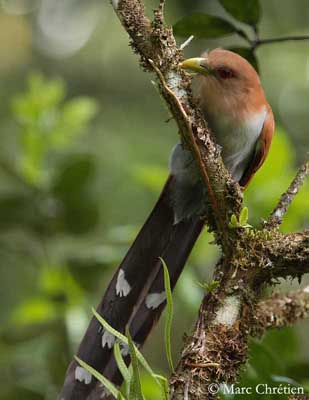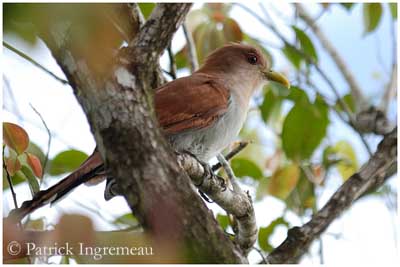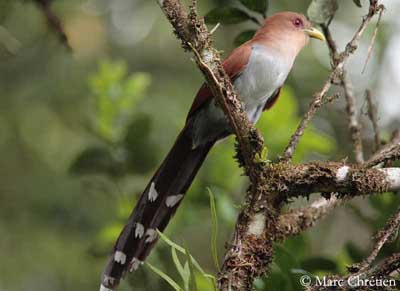
Squirrel Cuckoo
Piaya cayana
Cuculiforme Order – Cuculidae Family
BIOMETRICS:
Length : 45-50 cm
Weight : 98-110 g
DESCRIPTION:
Squirrel Cuckoo resembles Red Squirrel when moving along branches with its rufous plumage and its long tail.
Adult male has rich chestnut upperparts. Long dark chestnut tail is tipped black and white.
On the underparts, chin and throat are pale reddish. Breast and belly are grey, darker on belly and flanks. Undertail coverts are black. Undertail is dark chestnut with white-tipped feathers.
Head is chestnut. Down-curved, strong bill is yellow-green. Eyes are red, with bare yellow-green skin as eye-ring. Legs and feet are pale bluish-grey.
Both sexes are similar.
Juvenile resembles adults, but it is paler, and central tail feathers lack black tips above. Bill is greyish. Eyes are brown.
DIET:
Squirrel Cuckoo feeds mainly on large insects, cicadas, wasps and caterpillars (green or with hair or spines), and sometimes spiders and small lizards. It rarely takes fruits.
PROTECTION / THREATS / STATUS:
Squirrel Cuckoo’s populations are not globally threatened. This species is common or very common in most parts of its wide range.
Fr: Piaye écureuil
All : Eichhornkuckuck
Esp : Cuco-ardilla Común
Ital : Cuculo scoiattolo della Cayenna
Nd : Eekhoornkoekoek
Russe : Пиайя
Photographs by Marc Chrétien
His website :
MURINUS
Photograph by Patrick Ingremeau
His website : TAMANDUA
Text by Nicole Bouglouan
Sources:
PORTRAITS D’OISEAUX GUYANAIS - Groupe d'étude et de protection des oiseaux en Guyane (GEPOG) - Ibis rouge éditions - ISBN: 2844501842
A GUIDE TO THE BIRDS OF MEXICO AND NORTHERN CENTRAL AMERICA by Steve N. G. Howell, Sophie Webb - Oxford University Press - ISBN: 0198540124
A GUIDE TO THE BIRDS OF COLOMBIA by Steven L. Hilty and William L. Brown - Princeton University Press – ISBN 069108372X
Arthur Grosset's Birds (Arthur Grosset)
Wikipedia (Wikipedia, The Free Encyclopedia)

We can find two similar species:
Black-bellied Cuckoo, with grey head, red bill, yellow lores and blackish belly and vent;
Little Cuckoo, smaller, with cinnamon-chestnut underparts and shorter tail.
There are 14 subspecies varying in coloration and plumage pattern. Main subspecies are:
P.c. mexicanus, from W Mexico, is brighter and paler;
P.c. thermophila, from E Mexico and Central America, is darker overall with black undertail broadly tipped white.
VOICE: SOUNDS BY XENO-CANTO
Squirrel Cuckoo utters explosive “chik” followed by gruff “whrrr”. It also gives variations such as “chik-chik”, nasal “chek-e-rehr”, and loud “ch’kaow”.
Song is a prolonged series of sharp notes “pee’uk pee’uk…” or whistled notes “wheek wheek wheek…” mainly uttered in April-August.
HABITAT:
Squirrel Cuckoo lives in forests and woodlands, in canopy and edges. Tropical forests can be evergreen, deciduous, old secondary, gallery, flooded evergreen forest, and mangroves. It also frequents coffee plantations, shrubbery, pastures with trees, areas along watercourses in dry regions, and also residential areas.
This species can be found from sea level to 2700 metres of elevation. However, it avoids too dense forests.
RANGE:
Squirrel Cuckoo lives in Mexico and Central America, and in South America from Peru to North Argentina and Uruguay.
BEHAVIOUR:
Squirrel Cuckoo feeds mainly on large insects which it takes off the foliage. It gleans in canopy and sub canopy, often in pairs, sometimes alone or in mixed groups. Occasionally, it can follow army-ants swarms.

Its feeding behaviour makes it very similar to Red Squirrel. Squirrel Cuckoo hops along branches, through foliage, in bounding leaps. It hops from branch to branch; it also runs along limbs as a squirrel, and glides with bursts of shallow wing beats for crossing open spaces. It forages in foliage, gleaning insects on leaves. It can also catch flying insects with fluttering flight.
Squirrel Cuckoo is resident in its range. It is not brood parasite of other bird’s species. It builds a nest and rears its young.
FLIGHT:
Squirrel Cuckoo is able to catch flying insects, performing short fluttering flights. When foraging in trees, among foliage, it crosses open spaces between trees by gliding. Squirrel Cuckoo is able to perform sustained flights.
REPRODUCTION:
Breeding season varies, according to the place.
Both adults build the cup-shaped nest in dense shrubbery or in trees. It is a shallow platform made with leaves, or also with sticks and fresh leaves. Sticks and twigs are used as foundations. Nest is well concealed in dense vegetation, on large branch.
Female lays 2 to 3 white eggs. Incubation lasts about 18 to 20 days, shared by both parents. Each turn lasts about 6 to 8 hours.
Chicks are covered with down at hatching. They are fed and cared by both parents. They are fed with large insects.
They leave the nest relatively soon after hatching, and before they can fly, at about 8 to 10 days of age. If disturbed, they can climb around the nest.
This species can produce several broods per year.
